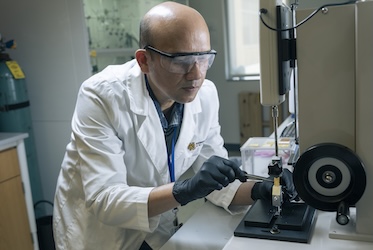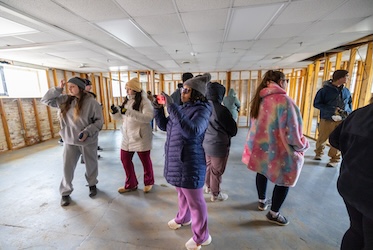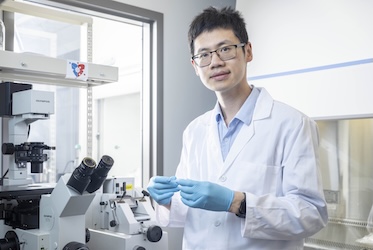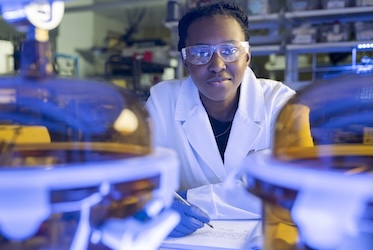
Green Learning Spaces
KENNESAW, Ga. | Sep 25, 2017
Outdoor areas provide unique educational opportunities
Students in Dan Ferreira’s environmental science class huddled around a truck bed, listening intently to their professor explain the soil sample that was extracted from 12 feet below. To better understand the soil composition, the students handled each of the layer’s different textures and brushed the dirt remnants from their soil-stained hands.
“Your hands will get dirty in this class,” said Ferreira, assistant professor of environmental science, as one student quickly chimed, “I’m not disappointed, I’m excited about it.”
Heading outdoors for class is one way that some Kennesaw State faculty are enriching their discipline’s academic curriculum and providing students with real-world, hands-on opportunities.
“Experiential learning is a big deal,” said Ferreira, a soil chemistry expert. “Anytime we can get the students excited and engaged about what they are learning, it’s great.”

Ferreira brought his students to the low-lying area near the arboretum on the Kennesaw Campus to learn about groundwater flow. A local engineering firm permanently installed three wells, offering Ferreira access to evaluate the area’s water table levels.
“My future classes will be able to monitor and measure the groundwater flow and have real data to use for our labs,” he added. The installed wells will monitor up to 15 feet below the surface.
Unique Spaces
Classes like Dan Ferreira’s are capitalizing on the green outdoor spaces on the Kennesaw and Marietta campuses to enhance learning experience for students.
Art and architecture students frequently sketch buildings and the campus as part of their classes, and civil engineering students survey the land as part of their academic requirements.
Some green learning spaces have specific purposes. On the roof of the Engineering Technology Center, students in Scott Tippen’s solar photovoltaics course have used the space for lab sessions. While the solar panels were built on the roof to offset the electricity needs of the entire building, Tippens, a professor of computer engineering technology, said its dual purpose benefits engineering students.
“When you are learning about solar energy, it makes sense for your classroom to be outside,” he said. “As an intro to alternative energy course, they learn about energy conversion and how solar photovoltaics can create electricity.”
Students test their designs and performance, as they explore solar thermal energy and heat with radiant energy. Tippens finds that this space is ideal, with no obstructing trees or buildings which could impede their lab work or research.
The Oasis, an outdoor classroom built in the unused courtyard space between the Science Building, Science Laboratory building and the Clendenin Building, provides biology students a space to study native Georgia plant life.
According to R.C. Paul, former director of sustainability and professor of biology, it is one of the most unique and innovative laboratory spaces on campus. Used by biology faculty, the space was funded by Joseph Cook, a retired Florida professor.
“Even though the pond is completely enclosed on all sides by the building, yet open at the top, birds have flown over and found the water source in this ecosystem,” Paul said.
In the Architecture building, student-developed prototypes of green roofs and walls enable discovery in urbanscapes and vertical gardening, and a new rainwater collection system will soon be installed, adding another component to teaching about sustainable development in an outdoor space.
The Farm
Teaching about sustainability is the norm for the University’s Hickory Grove Farm with its expansive 26 acres, containing a 4,000 square-foot greenhouse and honey bee apiaries, for student learning.
Jorge E. Perez Arocho, a lecturer in the Leven School of Culinary Sustainability and Hospitality, teaches organic agriculture and beginning apiary studies, where he focuses on helping students understand sustainable ways to grow produce.

“Many students have no experience with agriculture and think it’s easy to grow tomatoes or peppers, but then they realize how hard it is and that it takes time,” Perez said. Students may not be able to identify an herb plant, like basil, at the beginning, he explained, but by semester’s end students understand the biology of bees, health of the soil and cultivation techniques.
“Learning organic agriculture only in a classroom could be pretty boring if you aren’t seeing it in practice,” Perez added.
Nearly 100 students in three of Roneisha Worthy’s civil engineering classes recently designed a sustainable chicken coop for 200 chickens that is mobile and low in cost.
“This is the first civil engineering course that most of these students will take, and I thought it important for them to get the hands-on experience that many expect in the engineering field,” said Worthy, an assistant professor of engineering. “They may never design another chicken coop in their lifetime, but implementing the engineering design process and working with others to accomplish an ultimate goal is beneficial.”
Students in construction management also got their hands dirty at the farm while building a “tiny house.” This small structure will serve as a learning space for the farm, and will expose the wall materials so students can see the various layers of sustainable building.
Teaching Sustainability
Paul, who retired from the university in June after nearly 40 years, said that many spaces around campus have been created, or donated to the University, in order to preserve green space on campus.
Paul has led sustainability tours at the Kennesaw Campus for many years, telling the stories behind each green space. Each spring, he gathers faculty to help them learn how to incorporate sustainability into their curriculum.
Ecology, biology and environmental science classes, like Ferreira’s, have taken an interest in finding practical solutions to erosion and groundwater issues throughout campus, while other classes have traced the species and age of each tree in the arboretum and the walnut grove behind the Jolley Lodge.
But learning is not limited to those in the hard sciences. A dance improvisation class takes students outdoors to interact with nature and outdoor space, and a communications class shows students how radar works from outside the Wilder Communications Center on the Marietta Campus.
Regardless of major, students who actively learn in an outdoor space can more easily grasp concepts through hands-on learning and they say they find it much more fun than the traditional classroom.
Environmental science major Katurah Warfield said that it’s easier to learn hands on. “The problems are easier to understand when it’s hands on,” she said. “I definitely learn better by seeing it.”
Outdoor learning spaces, like the University’s greenhouse, arboretum or amphitheater are obvious spaces for learning and research, and the ways students learn in these spaces are as varied as the disciplines they study. Kennesaw State faculty are continually looking for ways to increase their efforts to take learning into outdoor spaces – to strengthen the curriculum and enhance students’ academic experience.
– Tiffany Capuano
Photos by David Caselli and Lauren Kress
***
To read more of Kennesaw State University Magazine, click here.
Related Stories

Kennesaw State researcher tackling sustainability through use of transparent wood

Kennesaw State architecture, engineering students reimagine Asheville's devastated River Arts District

KSU researcher harnessing digital twin technology to improve heart care

Chemistry student engaged in sustainable catalyst research through Kennesaw State's First-Year Scholars program
A leader in innovative teaching and learning, Kennesaw State University offers undergraduate, graduate, and doctoral degrees to its more than 47,000 students. Kennesaw State is a member of the University System of Georgia with 11 academic colleges. The university’s vibrant campus culture, diverse population, strong global ties, and entrepreneurial spirit draw students from throughout the country and the world. Kennesaw State is a Carnegie-designated doctoral research institution (R2), placing it among an elite group of only 8 percent of U.S. colleges and universities with an R1 or R2 status. For more information, visit kennesaw.edu.















